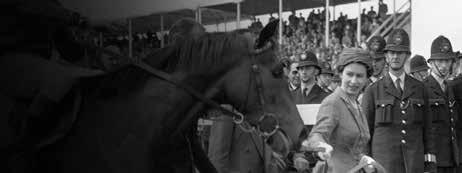
2 minute read
JOCKEY
Although The Queen enjoyed many more successes in major races, including 23 Royal Ascot winners – headed by Estimate in the 2013 Gold Cup, of whom there is a huge sculpture at Sandringham House – the Derby continued to elude her. In 2011 all the pre-race publicity surrounded the Sir Michael Stoute-trained Carlton House, given to her by the ruler of Dubai, Sheikh Mohammed. The colt was sent off the 5/2 favourite for the world’s most famous Flat race under Ryan Moore but could only finish third.
Undoubtedly a source of great pleasure to The Queen and her primary leisure activity, her racing and breeding operation was, however, also a commercial one, and in 1982 the top-class filly Height Of Fashion – a daughter of Highclere - was sold to Sheikh Hamdan bin Rashid al Maktoum for £1.2million and went on to produce the 1989 2,000 Guineas and Derby winner Nashwan and four-time G1 scorer Nayef.
Flat racing and breeding was The Queen’s love, but she appreciated Jump racing as well. She and her mother Queen Elizabeth shared the ownership of Monaveen, who gave her a first winner over fences at Fontwell in October 1949, and she inherited her mother’s jumps horses on the Queen Mother’s death in 2001. She continued to own a handful of horses under that code, and scored a first winner at Cheltenham with the Nicky Henderson-trained Sunshade in April 2019.
John Warren was her bloodstock and racing advisor from 2001, when he took over from his father-in-law, The Queen’s childhood friend Lord Carnarvon, who had held the reins since 1969.
She took great joy in spending time with her horses, at the Royal Studs and at their training yards, to which she was a relaxed and frequent visitor. Her horses are foaled at Sandringham, and go as yearlings to Polhampton Stud near Newbury before joining one of her trainers, who recently included Sir Michael Stoute, John & Thady Gosden, Richard Hannon, Andrew Balding, Michael Bell, Harry & Roger Charlton, William Haggas, Clive Cox, Nicky Henderson, Jamie Snowden and Gai Waterhouse in Australia.
She was a patron of both The Jockey Club and the Thoroughbred Breeders’ Association. The Queen also received two of the most prestigious awards in racing, taking the Cartier Millennium Award of Merit in 2000, and the Sir Peter O’Sullevan Charitable Trust Award in 2002.
The Queen’s involvement in the horse world stretched far beyond racing. As well as thoroughbreds, she bred Highland ponies, Cleveland Bays, polo ponies and sports horses – including Doublet, who carried her daughter Princess Anne to victory in the 1971 European Eventing Championships.



